小学四年级英语北师大版教案
- 格式:docx
- 大小:3.89 KB
- 文档页数:3
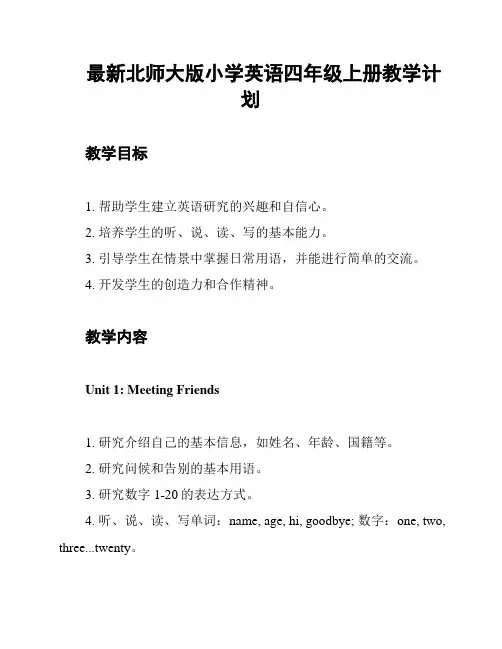
最新北师大版小学英语四年级上册教学计划教学目标1. 帮助学生建立英语研究的兴趣和自信心。
2. 培养学生的听、说、读、写的基本能力。
3. 引导学生在情景中掌握日常用语,并能进行简单的交流。
4. 开发学生的创造力和合作精神。
教学内容Unit 1: Meeting Friends1. 研究介绍自己的基本信息,如姓名、年龄、国籍等。
2. 研究问候和告别的基本用语。
3. 研究数字1-20的表达方式。
4. 听、说、读、写单词:name, age, hi, goodbye; 数字:one, two, three...twenty。
Unit 2: My Family1. 研究家庭成员的名称,如father, mother, brother, sister等。
2. 研究描述自己家庭成员的外貌特征。
3. 研究询问他人家庭成员的方式。
4. 听、说、读、写单词:family, father, mother, brother, sister。
Unit 3: My School1. 研究学校的基本设施名称,如classroom, playground, library 等。
2. 研究询问他人学校设施的方式。
3. 研究表达自己喜欢的研究科目。
4. 听、说、读、写单词:school, classroom, playground, library。
Unit 4: My Day1. 研究描述一天的活动安排。
2. 研究使用时间短语,如in the morning, in the afternoon等。
3. 研究询问他人一天的活动安排。
4. 听、说、读、写单词:today, morning, afternoon, evening。
教学活动1. 听力训练:通过听录音、听故事等活动,提高学生对英语语音的理解和听力能力。
2. 口语训练:通过角色扮演、对话练等活动,提高学生口语表达能力。
3. 读写训练:通过课文朗读、写作练等活动,培养学生的阅读和写作能力。
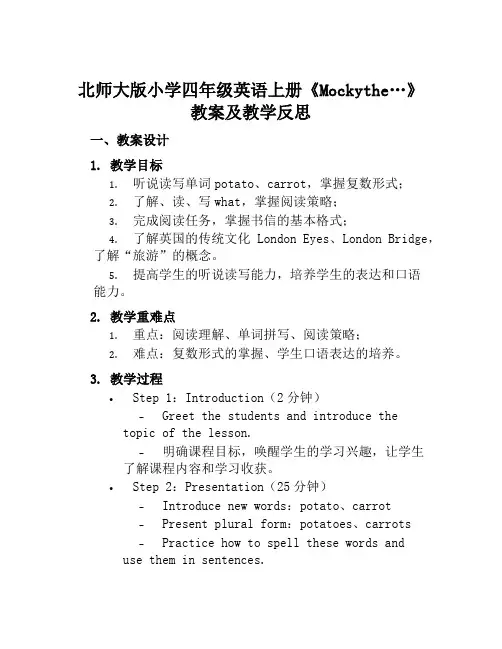
北师大版小学四年级英语上册《Mockythe…》教案及教学反思一、教案设计1. 教学目标1.听说读写单词potato、carrot,掌握复数形式;2.了解、读、写what,掌握阅读策略;3.完成阅读任务,掌握书信的基本格式;4.了解英国的传统文化London Eyes、London Bridge,了解“旅游”的概念。
5.提高学生的听说读写能力,培养学生的表达和口语能力。
2. 教学重难点1.重点:阅读理解、单词拼写、阅读策略;2.难点:复数形式的掌握、学生口语表达的培养。
3. 教学过程•Step 1:Introduction(2分钟)–Greet the students and introduce the topic of the lesson.–明确课程目标,唤醒学生的学习兴趣,让学生了解课程内容和学习收获。
•Step 2:Presentation(25分钟)–Introduce new words:potato、carrot–Present plural form:potatoes、carrots–Practice how to spell these words and use them in sentences.–Pay attention to the pronunciation and help students to solve the problem.•Step 3:Reading comprehension(20分钟)–First, give an introduction to the text.–Next, introduce “what” and the reading strategy.–Read the text together, and expln the parts or vocabulary words that are notunderstood.–Ask questions and check understanding after reading.•Step 4:Writing(15分钟)–Introduce the basic format of a letter.–Ask students to write a letter to a friend, describing their experiences of a tripto London in simple English.•Step 5:Conclusion(5分钟)–Summarize what we’ve learned in the lesson.–Ask students to share what they’ve learned or found challenging in the lesson.二、教学反思在这节课的教学实践中,有以下几点值得反思和总结。
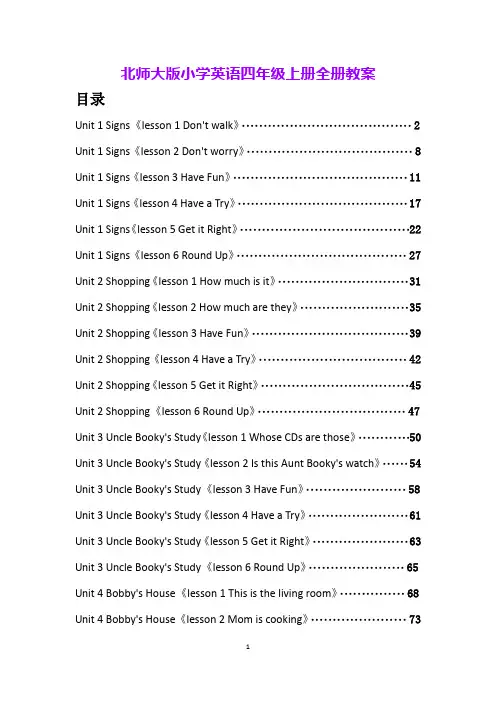
北师大版小学英语四年级上册全册教案目录Unit 1 Signs《lesson 1 Don't walk》 (2)Unit 1 Signs《lesson 2 Don't worry》 (8)Unit 1 Signs《lesson 3 Have Fun》 (11)Unit 1 Signs《lesson 4 Have a Try》 (17)Unit 1 Signs《lesson 5 Get it Right》 (22)Unit 1 Signs《lesson 6 Round Up》 (27)Unit 2 Shopping《lesson 1 How much is it》 (31)Unit 2 Shopping《lesson 2 How much are they》 (35)Unit 2 Shopping《lesson 3 Have Fun》 (39)Unit 2 Shopping《lesson 4 Have a Try》 (42)Unit 2 Shopping《lesson 5 Get it Right》 (45)Unit 2 Shopping《lesson 6 Round Up》 (47)Unit 3 Uncle Booky's Study《lesson 1 Whose CDs are those》 (50)Unit 3 Uncle Booky's Study《lesson 2 Is this Aunt Booky's watch》 (54)Unit 3 Uncle Booky's Study《lesson 3 Have Fun》 (58)Unit 3 Uncle Booky's Study《lesson 4 Have a Try》 (61)Unit 3 Uncle Booky's Study《lesson 5 Get it Right》 (63)Unit 3 Uncle Booky's Study《lesson 6 Round Up》 (65)Unit 4 Bobby's House《lesson 1 This is the living room》 (68)Unit 4 Bobby's House《lesson 2 Mom is cooking》 (73)Unit 4 Bobby's House《lesson 3 Have Fun》 (77)Unit 4 Bobby's House《lesson 4 Have a Try》 (80)Unit 4 Bobby's House《lesson 5 Get it Right》 (83)Unit 4 Bobby's House《lesson 6 Round Up》 (89)Unit 5 At school《lesson 1 What subjects do you have》 (91)Unit 5 At school《lesson 2 This is our classroom》 (95)Unit 5 At school《lesson 3 Have Fun》 (102)Unit 5 At school《lesson 4 Have a Try》 (105)Unit 5 At school《lesson 5 Get it Right》 (108)Unit 5 At school《lesson 6 Round Up》 (115)Unit 6 《Review》 (117)Unit 1 Signs《lesson 1 Don't walk》1教学目标1、听懂、会说Hello./Hi . Goodbye./Bye-Bye. I'm ...。
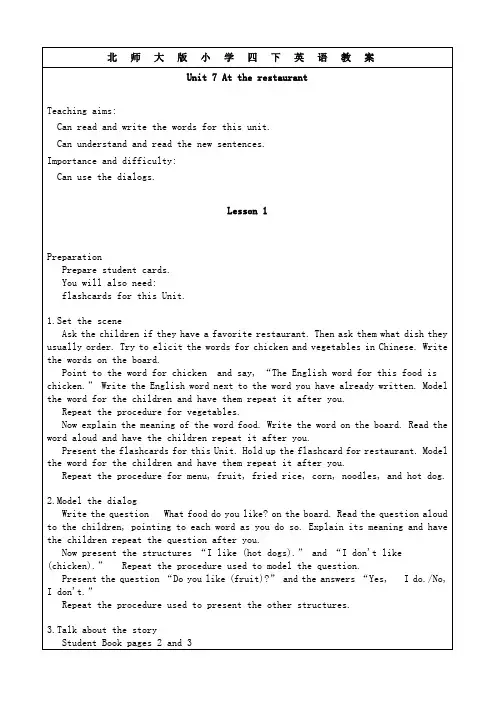
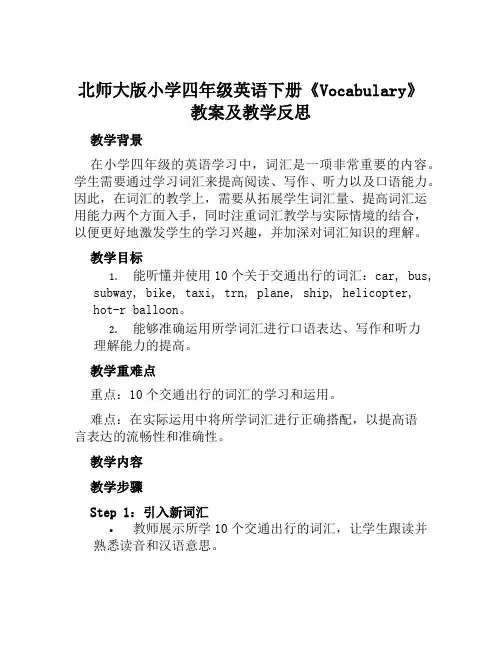
北师大版小学四年级英语下册《Vocabulary》教案及教学反思教学背景在小学四年级的英语学习中,词汇是一项非常重要的内容。
学生需要通过学习词汇来提高阅读、写作、听力以及口语能力。
因此,在词汇的教学上,需要从拓展学生词汇量、提高词汇运用能力两个方面入手,同时注重词汇教学与实际情境的结合,以便更好地激发学生的学习兴趣,并加深对词汇知识的理解。
教学目标1.能听懂并使用10个关于交通出行的词汇:car, bus,subway, bike, taxi, trn, plane, ship, helicopter,hot-r balloon。
2.能够准确运用所学词汇进行口语表达、写作和听力理解能力的提高。
教学重难点重点:10个交通出行的词汇的学习和运用。
难点:在实际运用中将所学词汇进行正确搭配,以提高语言表达的流畅性和准确性。
教学内容教学步骤Step 1:引入新词汇•教师展示所学10个交通出行的词汇,让学生跟读并熟悉读音和汉语意思。
•教师针对每个交通工具进行细致介绍,讲述其名称、用途、相关的英文词汇,以及该交通工具在日常生活中的使用场景。
Step 2:复习旧词汇•教师通过词汇卡片或图片的形式,复习并巩固学生已经掌握的词汇。
•教师可以通过掌握词块运用、句型填空、听写等活动来检查学生对已学习过的单词的熟练程度。
Step 3:搭配练习•教师针对所学单词进行搭配练习。
例如,教师说出:I go to school by bus. 学生需要明确表达“我坐公共汽车去学校。
”这样的句子。
Step 4:课堂练习•教师设计一些简单和有趣的词汇练习活动,如口语练习、听力练习、造句练习等,以检测学生掌握言语表达和接受能力的程度。
教学资源•词汇卡片或图片•课堂练习活动题目•思维导图或关键记忆点教学反思本次词汇教学是一次很好的体验,不仅学生们对交通工具相关词汇的学习效果很好,同时他们也很自然地通过学习掌握了交通工具的名称、用途、和使用场景。
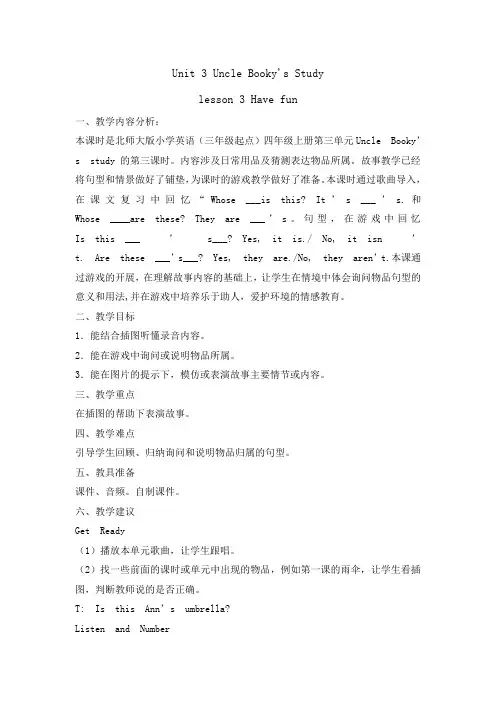
Unit 3 Uncle Booky's Studylesson 3 Have fun一、教学内容分析:本课时是北师大版小学英语(三年级起点)四年级上册第三单元Uncle Booky’s study的第三课时。
内容涉及日常用品及猜测表达物品所属。
故事教学已经将句型和情景做好了铺垫,为课时的游戏教学做好了准备。
本课时通过歌曲导入,在课文复习中回忆“Whose ___is this? It’s ___’s.和Whose ____are these? They are ___’s。
句型,在游戏中回忆Is this ___’s___? Yes, it is./ No, it isn’t. Are these ___’s___? Yes, they are./No, they aren’t.本课通过游戏的开展,在理解故事内容的基础上,让学生在情境中体会询问物品句型的意义和用法,并在游戏中培养乐于助人,爱护环境的情感教育。
二、教学目标1.能结合插图听懂录音内容。
2.能在游戏中询问或说明物品所属。
3.能在图片的提示下,模仿或表演故事主要情节或内容。
三、教学重点在插图的帮助下表演故事。
四、教学难点引导学生回顾、归纳询问和说明物品归属的句型。
五、教具准备课件、音频。
自制课件。
六、教学建议Get Ready(1)播放本单元歌曲,让学生跟唱。
(2)找一些前面的课时或单元中出现的物品,例如第一课的雨伞,让学生看插图,判断教师说的是否正确。
T: Is this Ann’s umbrella?Listen and Number(1)让学生看插图,看一看Uncle Booky的书房里都有什么。
教师可以说其中一两个物品,让学生指相应的插图。
(2)告诉学生接下来听录音,给图中物品标序号。
(3)再次播放录音,让学生给图中的物品标上序号。
(4)放录音,每次一句,教师重复,全班一起核对完成情况。
Game Time(1)告诉学生接下来玩一个游戏,把学生分成小组。
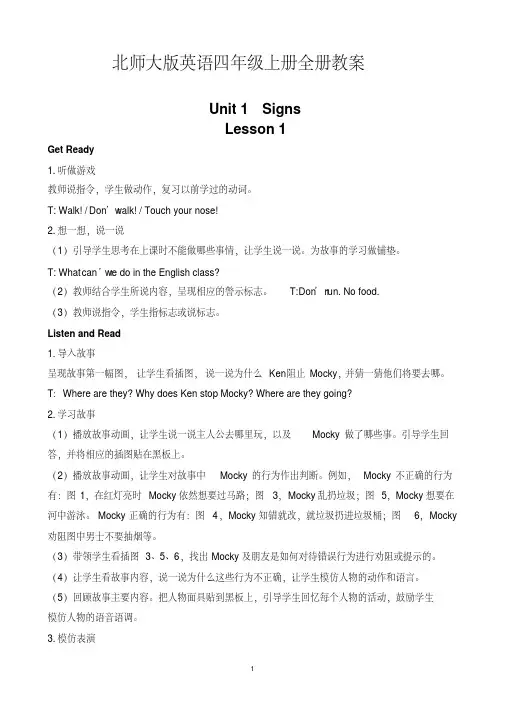
北师大版英语四年级上册全册教案Unit 1 SignsLesson 1Get Ready1. 听做游戏教师说指令,学生做动作,复习以前学过的动词。
walk! / Touch your nose!T: Walk! / Don’t2. 想一想,说一说(1)引导学生思考在上课时不能做哪些事情,让学生说一说。
为故事的学习做铺垫。
we do in the English class?T: What can’t(2)教师结合学生所说内容,呈现相应的警示标志。
T: D on’t run. No food.(3)教师说指令,学生指标志或说标志。
Listen and Read1. 导入故事呈现故事第一幅图,让学生看插图,说一说为什么Ken 阻止Mocky,并猜一猜他们将要去哪。
T:Where are they? Why does Ken stop Mocky? Where are they going?2. 学习故事(1)播放故事动画,让学生说一说主人公去哪里玩,以及Mocky做了哪些事。
引导学生回答,并将相应的插图贴在黑板上。
(2)播放故事动画,让学生对故事中Mocky的行为作出判断。
例如,Mocky不正确的行为有:图1,在红灯亮时Mocky依然想要过马路;图3,Mocky乱扔垃圾;图5,Mocky想要在河中游泳。
Mocky正确的行为有:图4,Mocky知错就改,就垃圾扔进垃圾桶;图6,Mocky 劝阻图中男士不要抽烟等。
(3)带领学生看插图3、5、6,找出Mocky及朋友是如何对待错误行为进行劝阻或提示的。
(4)让学生看故事内容,说一说为什么这些行为不正确,让学生模仿人物的动作和语言。
(5)回顾故事主要内容。
把人物面具贴到黑板上,引导学生回忆每个人物的活动,鼓励学生模仿人物的语音语调。
3. 模仿表演(1)让学生独立看插图、阅读故事。
(2)放录音,让学生指人物对话文本,跟读对话。
(3)呈现故事主要情节的插图,删去部分对话,让学生根据图片和语言提示,补全对话。
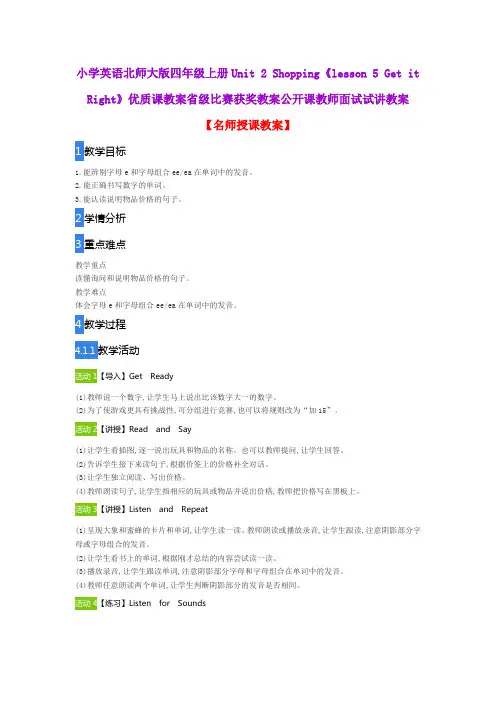
小学英语北师大版四年级上册Unit 2 Shopping《lesson 5 Get it Right》优质课教案省级比赛获奖教案公开课教师面试试讲教案
【名师授课教案】
1教学目标
1.能辨别字母e和字母组合ee/ea在单词中的发音。
2.能正确书写数字的单词。
3.能认读说明物品价格的句子。
2学情分析
3重点难点
教学重点
读懂询问和说明物品价格的句子。
教学难点
体会字母e和字母组合ee/ea在单词中的发音。
4教学过程
教学活动
1【导入】Get Ready
(1)教师说一个数字,让学生马上说出比该数字大一的数字。
(2)为了使游戏更具有挑战性,可分组进行竞赛,也可以将规则改为“加15”。
2【讲授】Read and Say
(1)让学生看插图,逐一说出玩具和物品的名称。
也可以教师提问,让学生回答。
(2)告诉学生接下来读句子,根据价签上的价格补全对话。
(3)让学生独立阅读、写出价格。
(4)教师朗读句子,让学生指相应的玩具或物品并说出价格,教师把价格写在黑板上。
3【讲授】Listen and Repeat
(1)呈现大象和蜜蜂的卡片和单词,让学生读一读。
教师朗读或播放录音,让学生跟读,注意阴影部分字母或字母组合的发音。
(2)让学生看书上的单词,根据刚才总结的内容尝试读一读。
(3)播放录音,让学生跟读单词,注意阴影部分字母和字母组合在单词中的发音。
(4)教师任意朗读两个单词,让学生判断阴影部分的发音是否相同。
4【练习】Listen for Sounds。
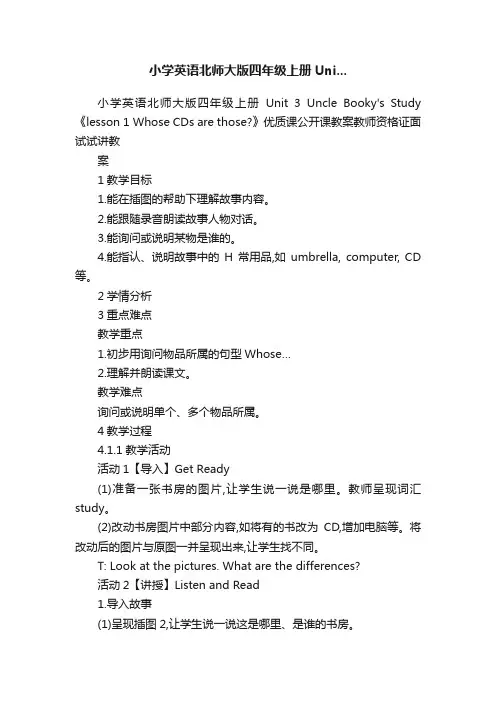
小学英语北师大版四年级上册Uni...小学英语北师大版四年级上册Unit 3 Uncle Booky's Study 《lesson 1 Whose CDs are those?》优质课公开课教案教师资格证面试试讲教案1教学目标1.能在插图的帮助下理解故事内容。
2.能跟随录音朗读故事人物对话。
3.能询问或说明某物是谁的。
4.能指认、说明故事中的H常用品,如umbrella, computer, CD 等。
2学情分析3重点难点教学重点1.初步用询问物品所属的句型Whose…2.理解并朗读课文。
教学难点询问或说明单个、多个物品所属。
4教学过程4.1.1教学活动活动1【导入】Get Ready(1)准备一张书房的图片,让学生说一说是哪里。
教师呈现词汇study。
(2)改动书房图片中部分内容,如将有的书改为CD,增加电脑等。
将改动后的图片与原图一并呈现出来,让学生找不同。
T: Look at the pictures. What are the differences?活动2【讲授】Listen and Read1.导入故事(1)呈现插图2,让学生说一说这是哪里、是谁的书房。
T: Look,where are they? What can you see?(2)让学生看插图,教师继续提问。
T: Is it clean?T:What a mess !T: Who can help Uncle Booky?2.学习故事(1)播放故事动画,让学生完整看一遍,然后说一说为什么Uncle Booky的书房比较乱。
T: Look, what a mess! Why?。
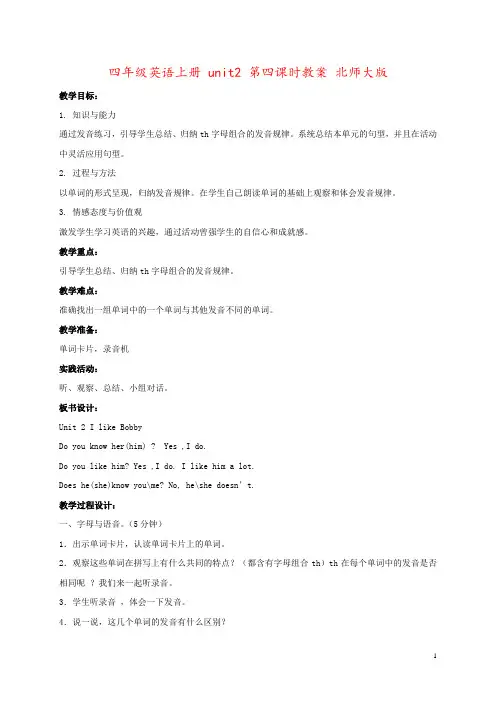
四年级英语上册 unit2 第四课时教案北师大版教学目标:1. 知识与能力通过发音练习,引导学生总结、归纳th字母组合的发音规律。
系统总结本单元的句型,并且在活动中灵活应用句型。
2. 过程与方法以单词的形式呈现,归纳发音规律。
在学生自己朗读单词的基础上观察和体会发音规律。
3. 情感态度与价值观激发学生学习英语的兴趣,通过活动曾强学生的自信心和成就感。
教学重点:引导学生总结、归纳th字母组合的发音规律。
教学难点:准确找出一组单词中的一个单词与其他发音不同的单词。
教学准备:单词卡片,录音机实践活动:听、观察、总结、小组对话。
板书设计:Unit 2 I like BobbyDo you know her(him) ? Yes ,I do.Do you like him? Yes ,I do. I like him a lot.Does he(she)know you\me? No, he\she doesn’t.教学过程设计:一、字母与语音。
(5分钟)1.出示单词卡片,认读单词卡片上的单词。
2.观察这些单词在拼写上有什么共同的特点?(都含有字母组合th)th在每个单词中的发音是否相同呢?我们来一起听录音。
3.学生听录音,体会一下发音。
4.说一说,这几个单词的发音有什么区别?5.再放录音,让学生跟读,体会发音规律。
6.指单个学生读单词,老师纠正一下发音情况。
二、听音练习。
(5分钟)1.指导学生看图,看图读出每个单词。
2.看第一行图片,大声读出来,找出那个不含/th/音的单词。
3.你们找得对不对呢?我们来听录音,要求学生一边听录音一边跟读。
4.那个单词的发音不含有/th/呢?指名同学来回答。
5.用同样的方法完成第二行插图。
设计意图:语音教学,采取循序渐进的方法,首先让学生听单词,体会发音的不同,然后试着总结出发音规律和方法,再做听音练习,最后让学生自己独立根据自己体会到的读出单词。
三、和Booky 大叔一起读。
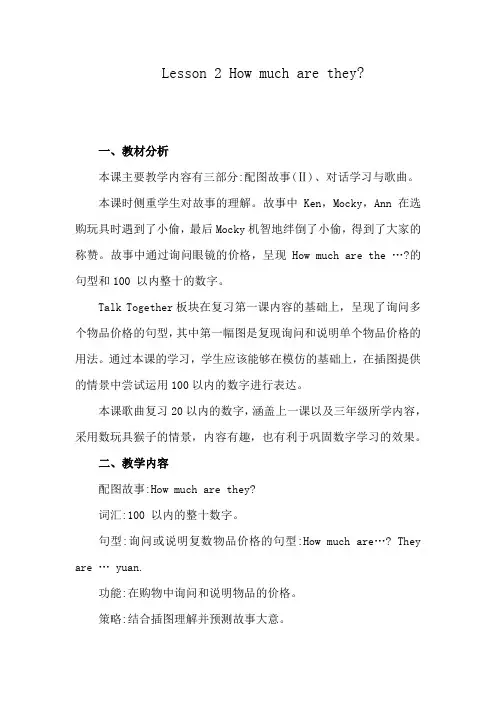
Lesson 2 How much are they?一、教材分析本课主要教学内容有三部分:配图故事(Ⅱ)、对话学习与歌曲。
本课时侧重学生对故事的理解。
故事中Ken,Mocky,Ann 在选购玩具时遇到了小偷,最后Mocky机智地绊倒了小偷,得到了大家的称赞。
故事中通过询问眼镜的价格,呈现How much are the …?的句型和100 以内整十的数字。
Talk Together板块在复习第一课内容的基础上,呈现了询问多个物品价格的句型,其中第一幅图是复现询问和说明单个物品价格的用法。
通过本课的学习,学生应该能够在模仿的基础上,在插图提供的情景中尝试运用100以内的数字进行表达。
本课歌曲复习20以内的数字,涵盖上一课以及三年级所学内容,采用数玩具猴子的情景,内容有趣,也有利于巩固数字学习的效果。
二、教学内容配图故事:How much are they?词汇:100 以内的整十数字。
句型:询问或说明复数物品价格的句型:How mu ch are…? They are … yuan.功能:在购物中询问和说明物品的价格。
策略:结合插图理解并预测故事大意。
三、教学目标在本课结束时,学生能够1.在插图和录音的帮助下理解故事并模仿人物对话。
2.询问或说明多个物品的价格。
3.指认、说出100 以内整十数字的名称。
4.通过学习故事中 Mocky 机智地捉住小偷的情节,培养机智、勇敢的品质。
四、教学重难点重点:在插图的帮助下理解并正确朗读故事。
难点:正确认读 100 以内整十数字的名称。
教学过程:Step 1 Warming upLet's sing 1-20 number song.通过歌曲复习旧知,便于导入新知,并且提高了学生学习热情。
Step 2呈现新知识。
(一)学习英文数字:(1)课件出示英文数字13-19与30-90之间的对比,让学生自主发现拼写和发音的规律。
(2)采取老师领读、学生个别读、集体读的形式进行练习。
北师大版小学英语四年级上册优质课教学设计与反思北师大版小学英语四年级上册优质课教学设计与反思教材分析1.这节课是北师大版小学英语四年级上册第三单元的对话课,课标对本节课的要求是:学生能熟读课文,会运用句型结合实际情景进行对话。
本节课是继第二单元How much 之后的继续学习,学习Whose 开头的问句及其的回答,为第四单元的学习做铺垫。
2.核心内容是能运用Whose .... ?It’s..../They’re...进行对话问答学情分析1.经过一年多的英语学习,学生已经初步具备了学习和感知英语会话的能力,能够理解一些简单的课堂用语,同时也具备了一定的接受新知识和句型的能力。
我相信,通过我的进一步教学,学生们将会掌握和运用这节课的新句型。
2.大三学生活泼好动。
在教学过程中,我会以教师为主导,以活动为主线,让学生积极参与互动对话,体现学生的主体地位和教师的引导作用。
教学目标1.知识目标:能认读单词 CD noise study walkman radio puter video television2.技能目标:能熟读课文对话;会运用下列句型介绍物品是谁的Whose .........It’s......../They’re.......3.情感目标:培养学生在实际情境中运用语言的能力,团队合作和竞争意识。
教学重点和难点重点:能熟练认读单词CD noise study walkman radio puter video television难点:会用本课句型Whose .........It’s......../They’re.......介绍某物是某人的教学过程一、导入新课1.生唱英语歌曲,师生问候,导入新课,板书课题Unit 3 Whose CDs !2出示学习目标(生齐读)二、先学、后教。
Task 1 Learning words1.出示自学指导一请仔细观察事物或图片,理解单词的意思,然后通过跟随多媒体阅读、小组阅读、小组阅读等形式进行记忆,比较谁学得快,读得准。
新北师大版四年级英语上册全册教案教学
设计
第一单元:Greetings
教学目标:
- 研究问候语:Hello、Hi、Good morning、Good afternoon、Good evening
- 研究回答问候语:Hello、Hi、Good morning、Good afternoon、Good evening
- 能够正确使用问候语进行简单的交流
教学步骤:
1. 导入新课:通过展示图片和视频引入本单元的主题,向学生
介绍问候语的重要性和使用场景。
2. 研究问候语:向学生展示问候语的图片和拼读音标,教授他
们正确的发音和用法。
3. 角色扮演:分组进行角色扮演练,让学生自由运用问候语进
行对话,鼓励他们使用多种表达方式。
4. 游戏活动:设计问候语游戏,让学生通过游戏练灵活运用问候语,增强记忆和理解。
5. 总结与拓展:通过小组讨论,总结本课程所学的问候语,并让学生在日常生活中应用和实践。
教学资源:
- 图片和视频素材:问候语的相关图片和视频
- 角色扮演卡片:包含不同问候语的卡片
- 游戏活动素材:问候语游戏卡片和道具
- 小组讨论记录表:用于记录学生在讨论中的发言和总结
教学评估:
- 角色扮演表现评估:观察学生在角色扮演活动中是否正确运用了问候语,并评估他们的口语表达能力。
- 游戏活动积分评估:根据学生在问候语游戏中的表现,进行积分评估,鼓励他们积极参与和竞争。
- 小组讨论记录评估:根据学生在小组讨论中的发言和总结情况,评估他们的思维能力和合作意识。
小学四年级英语北师大版教案
教案标题:小学四年级英语北师大版教案
教学目标:
1. 能够听懂、会说、会读、会写本课时的单词:apple, banana, orange, watermelon, pear。
2. 能够运用所学单词进行简单的问答和描述。
3. 能够正确使用句型"What fruit do you like?"和"I like..."进行交流。
教学重点:
1. 掌握本课时的五个水果单词。
2. 能够运用所学单词进行简单的问答和描述。
教学准备:
1. 北师大版四年级英语教材。
2. 单词卡片:apple, banana, orange, watermelon, pear。
3. 彩色水果图片。
4. 大型水果图片。
5. 教学PPT。
教学过程:
Step 1: Warm-up
1. Greet the students and review the previous lesson's vocabulary.
2. Show the students different fruit pictures and ask them to name the fruits they see.
Step 2: Presentation
1. Introduce the new vocabulary words: apple, banana, orange, watermelon, pear.
2. Show the students the corresponding word cards and pronounce each word clearly.
3. Use the pictures and word cards to teach the students the correct pronunciation and spelling of each word.
Step 3: Practice
1. Play a game of "Find the Fruit": Hide the word cards around the classroom and have the students find them. Once a student finds a card, they should say the word out loud and show it to the class.
2. Divide the class into pairs and have them practice asking and answering the question "What fruit do you like?" using the new vocabulary. Encourage them to use complete sentences, such as "I like apples." or "I don't like oranges."
3. Use the large fruit pictures to play a game of "Pass the Fruit": Pass a large fruit picture around the class while playing music. When the music stops, the student holding the picture should say the name of the fruit and a sentence about it. Step 4: Production
1. Have the students work in pairs or small groups to create their own mini-dialogues using the new vocabulary. They can use sentence frames like "Do you like ___?" and "Yes, I like ___." or "No, I don't like ___."
2. Select a few groups to perform their dialogues in front of the class.
Step 5: Conclusion
1. Review the new vocabulary words and the sentence structures learned in this lesson.
2. Assign homework, such as writing a short paragraph about their favorite fruit or drawing a picture of their favorite fruit.
教学扩展:
1. 教师可以使用多媒体资源,如视频或歌曲,来帮助学生巩固所学内容。
2. 引导学生在日常生活中观察和使用所学水果单词,加深记忆。
3. 鼓励学生与家人或朋友分享所学内容,提高口语表达能力。
教学评估:
1. 教师可以观察学生在课堂活动中的表现,如是否能正确发音和使用所学单词进行交流。
2. 对学生进行口头问答,测试他们对所学内容的理解和运用能力。
3. 检查学生完成的作业,评估他们对所学知识的掌握程度。
教学反思:
本节课通过多种形式的教学活动,帮助学生掌握了五个水果单词,并能够运用所学内容进行简单的问答和描述。
在教学过程中,教师可以根据学生的实际情况进行适当的调整,确保每个学生都能积极参与和有效学习。
同时,教师应鼓励学生在课后继续巩固所学内容,提高英语水平。